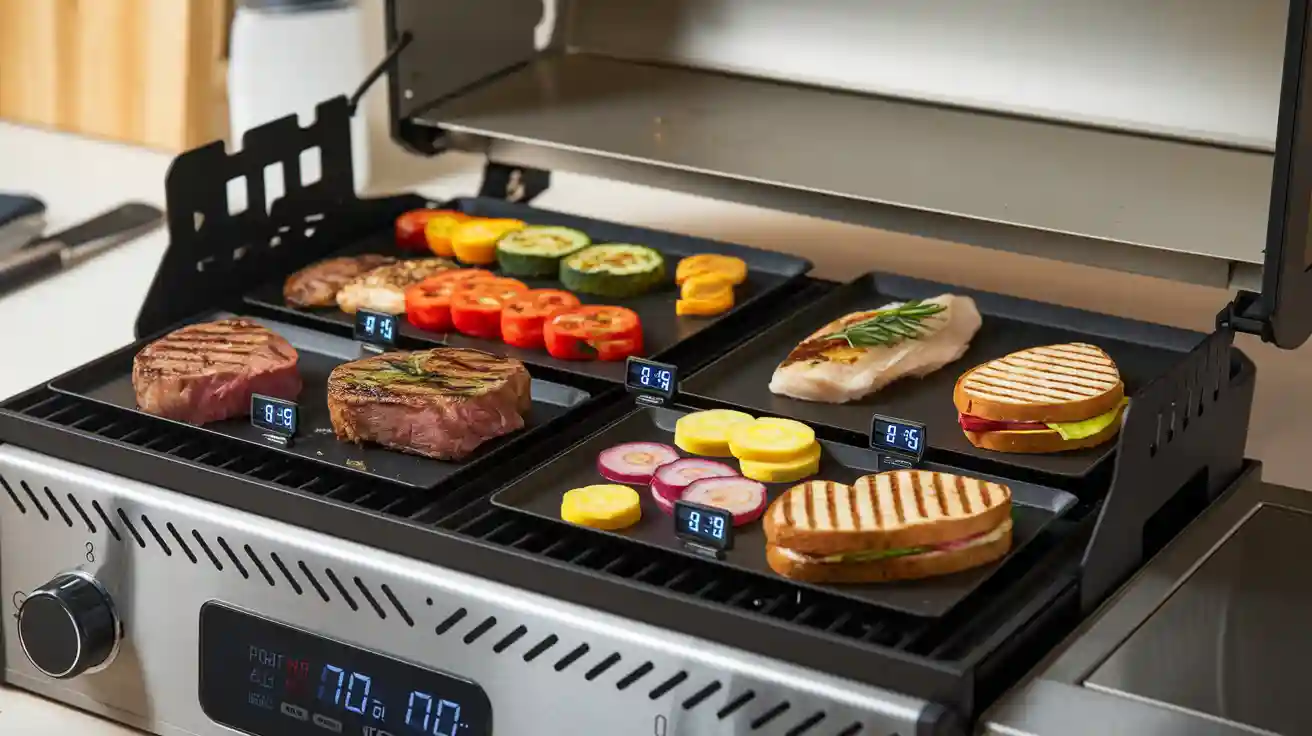
You achieve a perfect cook with the right grill contact temperature. Set the grill to 450°F for steak, 400°F for chicken, 375°F for fish, 350°F for vegetables, and 375°F for sandwiches. Use these ideal grill temperatures to keep food safe and tasty. Always check grill temperature before cooking.
Why Grill Temperature Matters for Taste and Safety
Taste and Texture Benefits of Correct Grill Temperature
You unlock the best flavors and textures when you use the right grill temperature. Food science shows that the Maillard reaction starts above 300°F. This reaction creates the rich, savory taste you love in steak, chicken, and vegetables. When you set the grill temperature high enough, you get a delicious crust on steak and a sweet, caramelized flavor on vegetables.
- The right grill temperature speeds up caramelization and the Maillard reaction, making meats and vegetables taste better.
- If you use too much heat, you risk charring your food. Charring can ruin the texture and create harmful compounds.
- Managing grill temperature helps you avoid overcooking and keeps nutrients in your food.
- For steak, a grill temperature zone between 450°F and 500°F gives you a perfect sear without burning.
- Chicken needs a steady grill temperature to cook through and stay juicy.
You should always use a thermometer to check the internal temperature. This helps you control the grill and get the best results every time.
Food Safety and Proper Temperature
You protect yourself and your family by cooking food to the right internal temperature. The USDA recommends these minimum internal temperatures for safety:
| Food Item | Minimum Internal Temperature | Rest Time |
|---|---|---|
| Steak (Beef, Pork, Veal, Lamb) | 145°F | At least 3 minutes |
| Chicken (All poultry parts) | 165°F | N/A |
| Fish & Shellfish | 145°F | N/A |
Grill temperature control is key for safety. Always check the internal temperature of steak, chicken, and fish before serving. Grilling temps that are too low may leave harmful bacteria. Use a thermometer to make sure every bite is safe.
How to Set and Check Grill Contact Temperature
Using Built-In Grill Temperature Controls
Modern contact grills make it easy for you to set the right temperature. Many new models have digital controls and independent thermostats for each plate. You can adjust the grill contact temperature with a simple dial or button. Some grills even let you set different temperatures for the top and bottom plates. This helps you cook food evenly and avoid burning. Advanced grills now offer features like timers, audio signals, and even Wi-Fi or Bluetooth connectivity. You can monitor and control grill temperature from your phone, making it easier to get perfect results every time.
| Feature | MultiGrill 7 CG 7044 | MultiGrill 9 CG 9043 |
|---|---|---|
| Heating Element | Embedded | Embedded |
| Temperature Controls | Dual Electronic | Dual Electronic |
| Max Temperature | 230°C | 250°C |
| Adjustable Thermostat | Yes | Yes |
| Independent Plate Control | Yes | Yes |
| Non-stick Surface | Premium PTFE | Premium PTFE |
Using a Grill Thermometer for Accuracy
You should always check the grill contact temperature before cooking. Contact thermometers give you the most accurate reading because they touch the grill surface directly. Brands like ThermoWorks use thermistor sensors that measure temperature with high precision. These probes last longer if you care for them and replace them when needed. Infrared thermometers are quick and easy, but they can give less reliable results. The grill surface material and finish can affect their accuracy. For best results, place the contact thermometer in the center of the grill and wait for a steady reading.
- Contact thermometers: Most accurate, need direct contact and careful placement.
- Infrared thermometers: Convenient, but less precise for grill contact temperature.
Practical Tips for Consistent Grill Temperature
You can control grill temperature and keep it steady with a few simple steps:
- Preheat the grill for 10-15 minutes before cooking.
- Clean the grill grates before and after use for even heat.
- Avoid overcrowding the grill to prevent flare-ups.
- Adjust the temperature as needed during cooking.
- Use a meat thermometer to check internal food temperature.
- Inspect and clean burners or heating elements often.
Tip: Indirect grilling works well for large cuts. This method helps you maintain a steady grill contact temperature and prevents burning.
Grill Temperature and Time Guide by Food Type
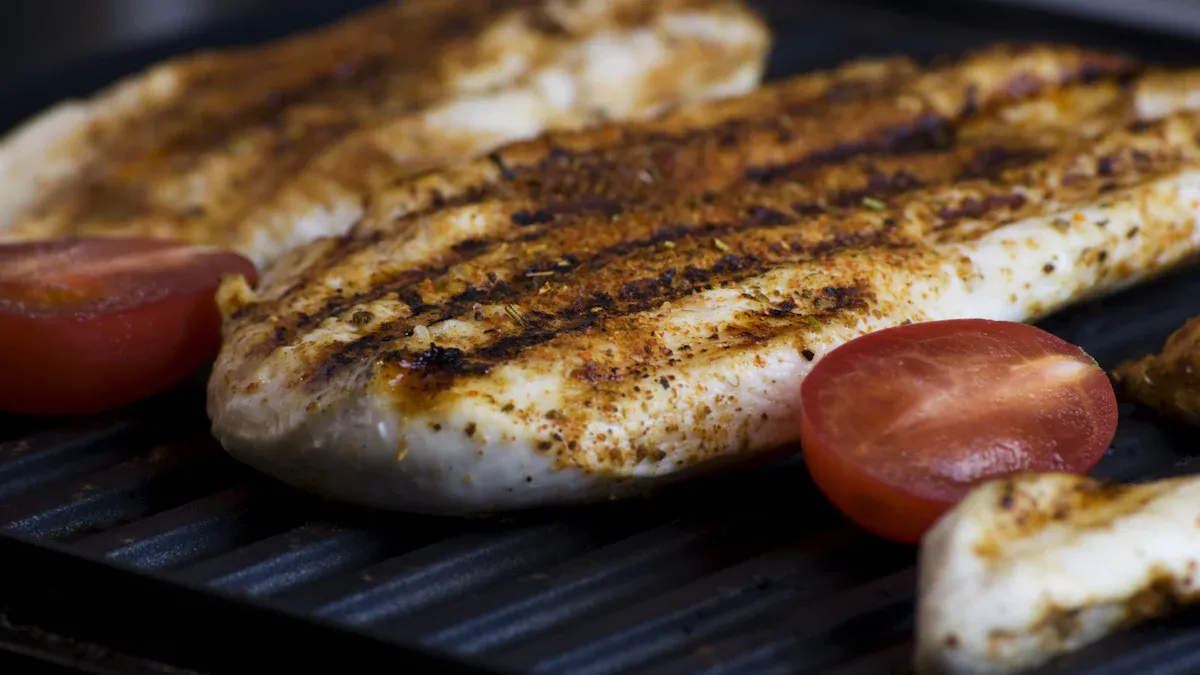
Grill Temp for Steak, Pork, and Lamb
You get the best results when you use the right grill temperature for steak, pork, and lamb. For steak, set your grill to 450°F. This grill temp for steak gives you a perfect sear and helps the Maillard reaction create a flavorful crust. Pork and lamb also benefit from high heat, but you must check the internal temperature to keep your food safe.
Here is a table to help you choose the right grill temperature and doneness level for steak, pork, and lamb:
| Meat | Doneness Level | Internal Temperature (°F) | Rest Time |
|---|---|---|---|
| Steak | Rare | 125 | 3 min |
| Steak | Medium Rare | 135 | 3 min |
| Steak | Medium | 145 | 3 min |
| Steak | Medium Well | 150 | 3 min |
| Steak | Well Done | 160 | 3 min |
| Pork | Medium Rare | 145 | 3 min |
| Pork | Medium | 150 | 3 min |
| Pork | Medium Well | 155 | 3 min |
| Pork | Well Done | 160 | 3 min |
| Lamb | Rare | 145 | 3 min |
| Lamb | Medium Rare | 160 | 3 min |
| Lamb | Medium | 170 | 3 min |
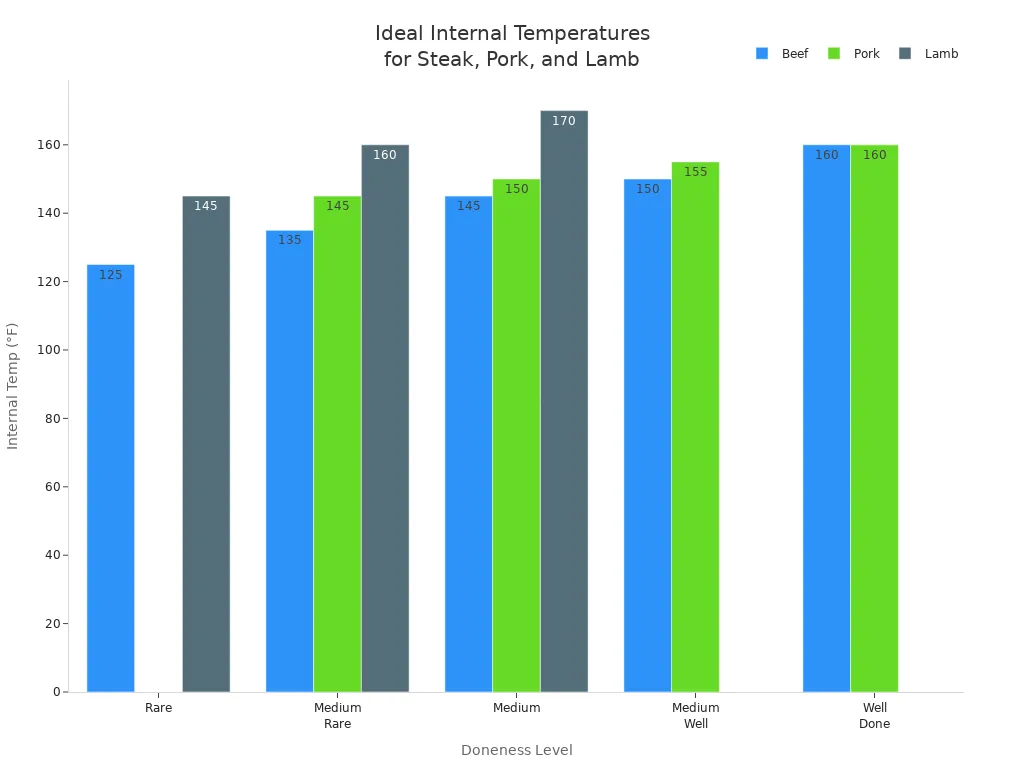
You should always use a meat thermometer to check the temperature. For hamburgers, set the grill temp for hamburgers to 400°F and cook until the internal temperature reaches 160°F. This keeps hamburgers safe to eat. The grill temp for steak and hamburgers is not the same, so always check your settings.
Note: Undercooked steak, pork, or lamb can cause foodborne illness. Always rest your meat for at least three minutes after grilling. This rest time helps the temperature stay high enough to kill bacteria.
Grill Temp for Chicken and Turkey
Chicken and turkey need careful temperature control. The grill temp for chicken should be 400°F for most cuts. For chicken breast, use a grill temp for chicken breast of 425°F to 450°F. This helps you get a juicy inside and a crisp outside. For chicken thighs, set the grill temp for chicken thighs to 375°F to 400°F. For chicken drumsticks, use a grill temp for chicken drumsticks of 375°F to 400°F.
Here is a quick guide for chicken and turkey:
| Chicken Cut | Grill Temperature (°F) | Cooking Duration | Internal Temperature (°F) | Notes |
|---|---|---|---|---|
| Whole Chicken | 350 to 400 | 45 min to 1 hour | 165 | Use indirect heat for even cooking |
| Chicken Breast | 425 to 450 | 12 to 16 min | 165 | Sear first, then finish on indirect heat |
| Boneless Thighs | 375 to 400 | 15 to 20 min | 165 | Cook over direct heat |
| Bone-In Thighs | 400 (direct), 300 (indirect) | 20 to 25 min | 165 | Sear, then finish on indirect heat |
| Chicken Legs | 375 to 400 | 30 to 35 min | 165 | Start direct, finish indirect |
| Chicken Wings | 375 to 400 | 15 to 20 min | 165 | Turn every 3 min for even cooking |
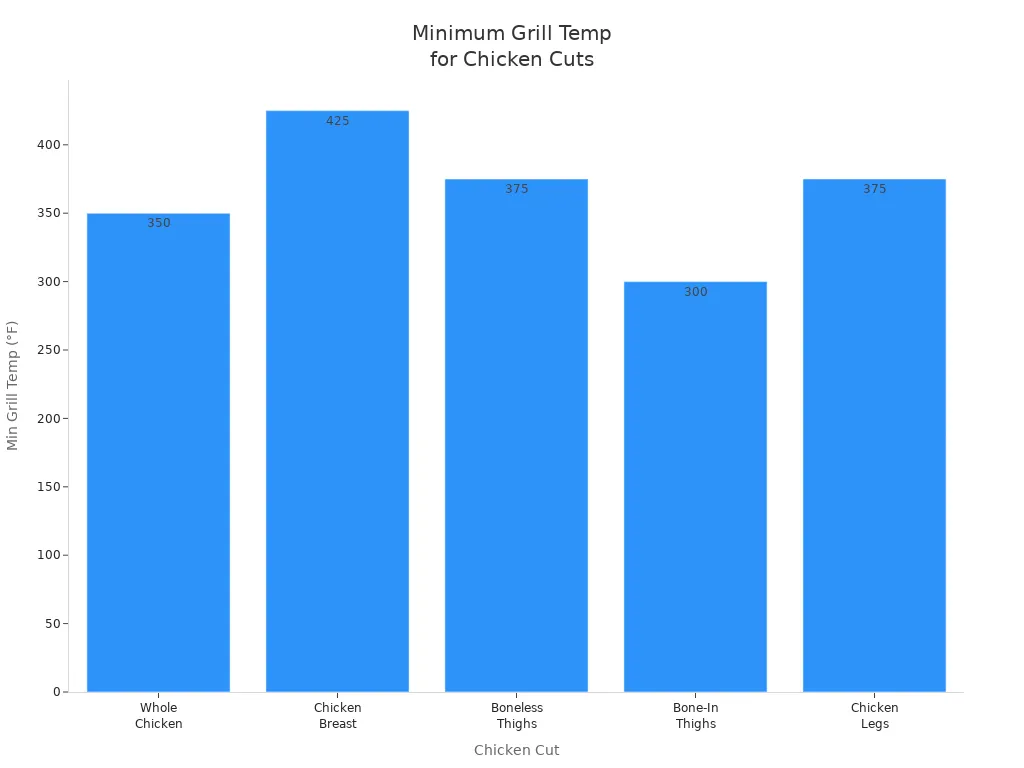
You must always check the internal temperature of chicken. The safe temperature is 165°F. Never rely on color alone. Use a thermometer to make sure your chicken is safe and juicy. For turkey, use similar grilling temps and always check for 165°F inside.
Grill Temperature for Fish and Seafood
Fish and seafood need gentle heat and careful timing. The grill temp for fish should be 375°F. For salmon, use a grill temp for salmon of 375°F to 400°F. For tuna steak, set the grill temp for tuna steak to 400°F. Swordfish does best at a grill temp for swordfish of 400°F. Shrimp cooks well at a grill temp for shrimp of 375°F to 400°F.
- Salmon: Cook to 125°F for moist texture. The FDA recommends 145°F, but many chefs prefer 125°F for better flavor.
- Halibut: Grill until the internal temperature is 130-135°F.
- Tuna steak: Best served rare, below 115°F, to keep it tender.
- Swordfish: Grill to 135-140°F for a firm, juicy bite.
- Shrimp: Cook to 135-140°F. Overcooking makes shrimp tough.
- Scallops: Sear quickly to 130°F until they turn opaque and firm.
Fish muscle cooks fast because it has short fibers. You must watch the grill temperature closely to avoid overcooking. For whole fish, use a lower grill temperature and cook longer to keep the inside moist.
Tip: Always use a thermometer for fish and seafood. If you do not have one, look for flesh that turns opaque and flakes easily. For shellfish, cook until the shells open. Discard any that stay closed.
Food safety is important with fish. Store seafood cold, thaw it safely, and never leave it out for more than two hours. Always clean your grill before cooking fish to avoid bacteria.
Grill Temperature for Vegetables
Vegetables need a moderate grill temperature to keep their nutrients and get a good texture. Set your grill to 350°F to 400°F for most vegetables. This range helps you caramelize the outside without burning or losing vitamins.
| Heat Level | Temperature Range (°F) | Recommended For |
|---|---|---|
| Medium-high heat | 400°F to 450°F | Dense vegetables, chicken |
| Medium heat | 350°F to 400°F | Fish, skewers (kebabs) |
| Medium-low heat | 300°F to 350°F | Thick cuts of meat |
| Low heat | 250°F to 300°F | Smoking, slow-cooking |
You should cut vegetables evenly, at least 1/2-inch thick, for even cooking. Use oil to prevent sticking and help spices stick. Grill baskets work well for small or delicate vegetables. Turn vegetables often to avoid burning. For root vegetables like carrots or beets, parboil before grilling to keep the inside soft.
- Grill at 400-425°F for 20-25 minutes for most vegetables.
- Use indirect heat for thick or dense vegetables.
- Avoid excessive charring to keep nutrients and prevent harmful compounds.
Note: Grilling vegetables without water keeps more nutrients than boiling. Marinate vegetables for 30-40 minutes before grilling to boost flavor.
Grill Temperature for Sandwiches and Paninis
Sandwiches and paninis need a steady grill temperature for crisp bread and melted cheese. Set your grill to 375°F for grilled cheese or simple sandwiches. For larger sandwiches with meat, use a lower grill temperature of about 200°F. This helps heat the meat without burning the bread.
| Sandwich Type | Recommended Grill Temperature | Grilling Time | Purpose/Notes |
|---|---|---|---|
| Grilled cheese-style | 375°F (medium-high) | ~3 minutes | Melt cheese and crisp bread evenly |
| Substantial sandwiches with meat | 200°F (low heat) | ~10 minutes | Heat meat through without burning bread |
Tip: Start with medium heat, then lower the grill temperature to finish. This prevents burning and gives you a golden, crispy crust. Use clarified butter or mayonnaise for better browning. Let your sandwich rest for a minute after grilling so the cheese sets and fillings stay inside.
Hamburgers also need the right grill temperature. Set the grill temp for hamburgers to 400°F and cook until the internal temperature is 160°F. This keeps hamburgers juicy and safe.
Checking Doneness and Food Safety with Temperature
Internal Temperature Guidelines for Each Food
You must always check the internal temperature of your food to make sure it is safe to eat. Food safety organizations set clear rules for the minimum internal temperature for different foods. Use a meat thermometer to check the thickest part of the food, avoiding bone and fat. This step helps you avoid undercooking or overcooking. The following table shows the recommended internal temperature for steak, chicken, fish, and vegetables:
| Food Type | Minimum Internal Temperature (°F) |
|---|---|
| Steak (Beef, Veal, Lamb Steaks & Roasts) | 145 |
| Chicken (Turkey, Chicken & Duck Whole, Pieces & Ground) | 165 |
| Fish | 145 |
| Vegetables | N/A (No specific guideline provided) |
You should always use these numbers as your guide. For steak, check the steak internal temperature before removing it from the grill. For chicken, always reach 165°F, especially when using the grill temp for chicken. Fish needs to reach 145°F to be safe. Hamburgers must also reach 160°F to kill harmful bacteria. Never rely on color alone, as it can be misleading.
Simple Methods to Check Doneness on a Contact Grill
You can use several methods to check doneness on a contact grill. The most reliable way is to use a thermometer to measure the internal temperature. However, you can also use visual and tactile cues to help you judge doneness:
- Look for color changes in meats. Steak turns from red to brown as it cooks. Chicken becomes white and opaque. Fish flakes easily and turns opaque.
- Press the food gently. Firmness increases as food cooks. For steak, use the finger test. Touch your thumb to each finger and compare the firmness of your palm to the steak:
- Thumb to pointer finger: rare
- Thumb to middle finger: medium-rare
- Thumb to ring finger: medium
- Thumb to pinky: well-done
- Use the finger test for steak and similar cuts. This method helps you avoid cutting into the meat and losing juices.
- For hamburgers, check that the juices run clear and the internal temperature reaches 160°F.
- For fish, look for flesh that flakes with a fork and turns opaque.
Tip: Always combine sensory cues with a thermometer for the most accurate results. Visual and tactile checks help, but only the correct internal temperature guarantees food safety.
Quick-Access Grill Temperature Chart and Checklist

Temperature Cheat Sheet for Contact Grills
You can use this chart as your quick grill temp guide. It helps you set the right grill temperature for every type of food. This table shows the best temperature ranges and safe internal temperatures for popular foods:
| Food Type | Grill Temperature Range (°F) | Internal Temperature (°F) | Notes |
|---|---|---|---|
| Steaks (1/2″) | 450-650 (High) | 115-160+ | Sear thin steaks quickly |
| Steaks (3/4-1″) | 375-450 (Medium High) | 115-160+ | Use for thicker steaks |
| Chicken Breast | 425-450 | 165 | Cook until juices run clear |
| Chicken Thighs | 400-450 | 165 | Slightly lower heat than breasts |
| Hamburgers | 400 | 160 | Cook ground beef fully |
| Salmon | 375-400 | 145 | Flesh should flake easily |
| Shrimp | 350-450 | 120 | Cook until opaque and firm |
| Vegetables | 350-400 | N/A | Grill until tender and caramelized |
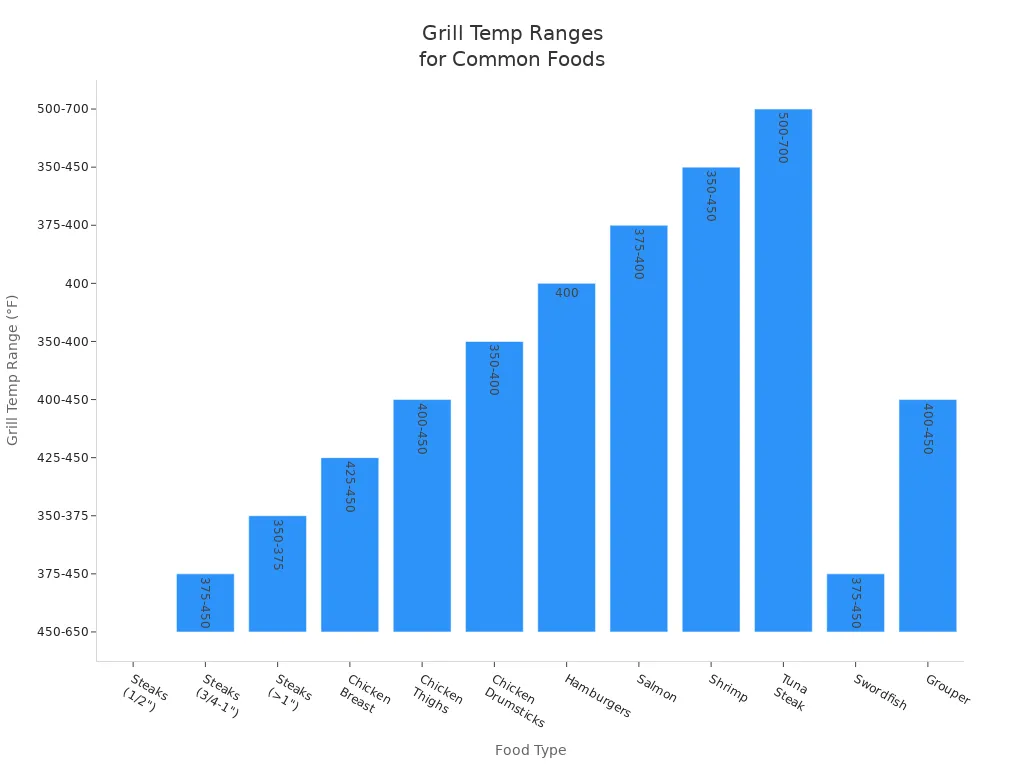
Tip: Always use a food thermometer to check the internal temperature. This keeps your meals safe and delicious.
Step-by-Step Cooking Checklist
You can follow this checklist to make sure your grilling is safe and successful every time:
- Clean your grill and check that it works well.
- Gather tools: tongs, spatula, grill brush, and meat thermometer.
- Prepare your food. Marinate meats and chop vegetables before you start.
- Preheat the grill to the right grill temperature for your food.
- Place food on the grill using clean tools. Keep raw and cooked foods separate.
- Use a thermometer to check the internal temperature before serving.
- Cover cooked food to keep it warm and safe from bugs.
- Turn off the grill and clean it while it is still warm.
- Store leftovers right away and wash all utensils.
- Wash your hands before and after handling food.
Using a checklist helps you remember every step. It keeps your food safe and your grill in top shape. Experts say checklists also help prevent mistakes and improve food safety for everyone.
You achieve the best grilling results when you use a thermometer and follow safe temperature guidelines. Always check the chart before you cook. This habit keeps your food safe and delicious every time.
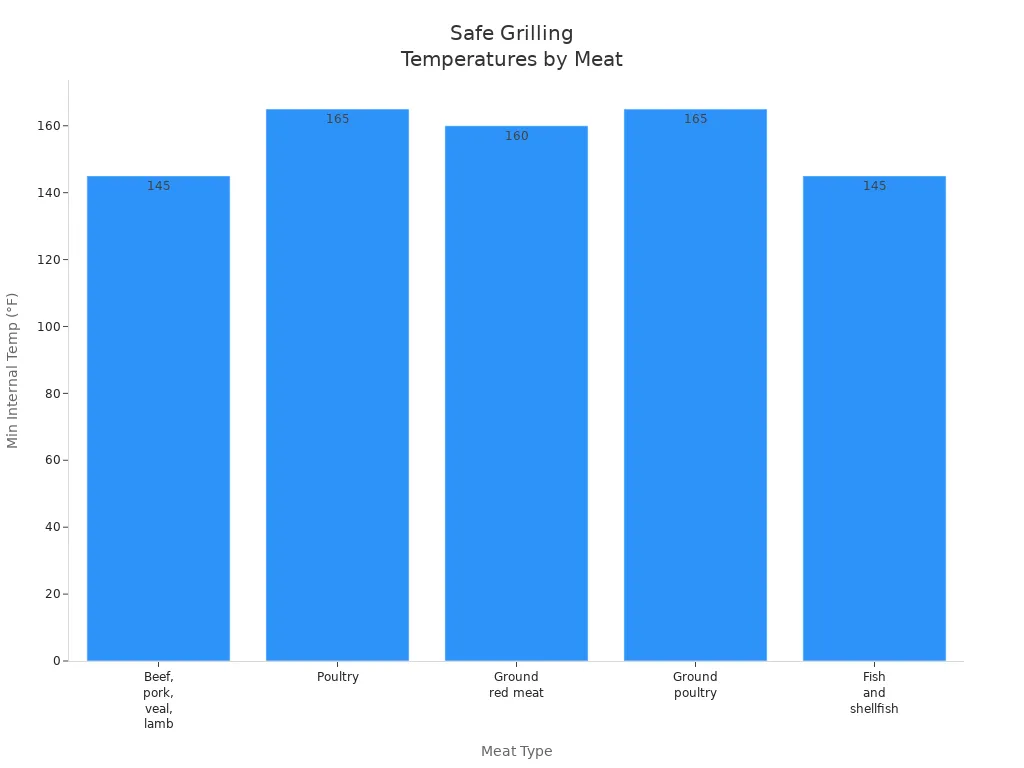
Use the checklist for every meal. The right temperature brings out flavor and protects your health.

FAQ
What should you do if your grill does not have temperature numbers?
You can use a grill thermometer to check the surface heat. Place it on the grill for an accurate reading before you start cooking.
Can you grill frozen food on a contact grill?
You should thaw food before grilling. Thawed food cooks more evenly and reaches a safe internal temperature faster.
How do you clean a contact grill after cooking?
Unplug the grill and let it cool. Wipe the plates with a damp cloth or sponge. Use a soft brush for stuck-on food.


